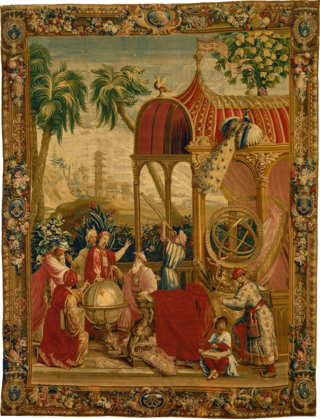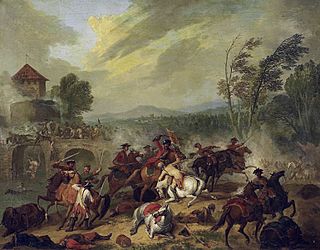

Jean-Baptiste Martin, known as "Martin des Batailles" (1659, Paris - 8 October 1735, Paris) was a French painter, decorator and designer who specialized in drawings for tapestries. He was best known for battle scenes, hence his nickname.


Jean-Baptiste Martin, known as "Martin des Batailles" (1659, Paris - 8 October 1735, Paris) was a French painter, decorator and designer who specialized in drawings for tapestries. He was best known for battle scenes, hence his nickname.
His father was a building contractor employed by the Bâtiments du Roi. [1] He began his career in the workshops of the late Laurent de La Hyre, [1] and later worked as a draftsman for Sébastien Le Prestre de Vauban, [2] by whose introduction he became apprenticed to Adam Frans van der Meulen. [2] His style soon came to be almost indistinguishable from Van der Meulen's and, after the latter's death in 1690, Martin and Sauveur Le Conte (another artist who specialized in battle scenes) were charged with completing a series of paintings honoring the achievements of King Louis XIV. That same year, partly in recognition of this work, he was appointed Director of the Gobelins Manufactory, succeeding Van der Meulen. [3]
After Lecomte's premature death in 1695, Martin began to collaborate with Pierre-Denis Martin who (depending on the source consulted) may have been his cousin, nephew or brother. In 1699, they completed a new series of works lauding the achievements of the King, which was installed at the Château de Marly. At this point, he became the official painter for the King's campaigns against the Protestants in Dauphiné, the Siege of Mons and the Siege of Namur. [2]
As a result of his position at Gobelins, many of his drawings and paintings were used for tapestries. He also executed frescoes for four rooms at the Hôtel des Invalides ( vedute depicting fortresses in the Netherlands, Flanders and Alsace). [3] In 1710, he was commissioned by Leopold, Duke of Lorraine, to create a series of works depicting the life of Leopold's father, Charles V, for the Château de Lunéville.
Although famous for painting battles, he also produced landscapes, portraits, still-lifes and historical scenes [2] and helped to reorganize the tapestry manufactory in Nancy.

Bernard van Orley, also called Barend or Barent van Orley, Bernaert van Orley or Barend van Brussel, was a versatile Flemish artist and representative of Dutch and Flemish Renaissance painting, who was equally active as a designer of tapestries and, at the end of his life, stained glass. Although he never visited Italy, he belongs to the group of Italianizing Flemish painters called the Romanists, who were influenced by Italian Renaissance painting, in his case especially by Raphael.

David Teniers the Younger or David Teniers II was a Flemish Baroque painter, printmaker, draughtsman, miniaturist painter, staffage painter, copyist and art curator. He was an extremely versatile artist known for his prolific output. He was an innovator in a wide range of genres such as history painting, genre painting, landscape painting, portrait and still life. He is now best remembered as the leading Flemish genre painter of his day. Teniers is particularly known for developing the peasant genre, the tavern scene, pictures of collections and scenes with alchemists and physicians.

J(oh)an and Jacob van Huchtenburg were two Dutch Golden Age painters in the second half of the seventeenth century. Both brothers were natives of Haarlem, moved to Paris, but died in Amsterdam. The main source about their lives is from Arnold Houbraken. Some of the information from the 19th century is contradictive.

Adam Frans van der Meulen or Adam-François van der Meulen was a Flemish painter and draughtsman who was particularly known for his scenes of military campaigns and conquests. Van der Meulen also painted portraits, hunting scenes, paintings of chateaux and landscapes. He created designs for prints and cartoons for tapestries.

Jean-Baptiste Oudry was a French Rococo painter, engraver, and tapestry designer. He is particularly well known for his naturalistic pictures of animals and his hunt pieces depicting game. His son, Jacques-Charles Oudry, was also a painter.

Jean-Baptiste Belin de Fontenay I (1653–1715), also called ‘Jean-Baptiste Belin the Elder’, was a French painter who specialized in flowers.

Pieter Boel or Peeter Boel was a Flemish painter, printmaker and tapestry designer. He specialised in lavish still lifes and animal paintings. He moved to Paris, where he worked in the gobelin factory and became a painter to the king. Pieter Boel revolutionized animal painting by working directly from live animals in a natural setting. He thus arrived at representations of animals showing them in their natural, characteristic poses. He had many followers in France.

Cornelis de Wael was a Flemish painter, engraver and merchant who was primarily active in Genoa in Italy. He is known for his genre paintings, battle scenes, history paintings and still lifes. Through his art work, support for Flemish painters working in Italy and role as an art dealer, he played an important role in the artistic exchange between Italy and Flanders in the first half of the 17th century. His work also had an influence on local painters such as Alessandro Magnasco, particularly through his scenes of despair and irony.

The Beauvais Manufactory is a historic tapestry factory in Beauvais, France. It was the second in importance, after the Gobelins Manufactory, of French tapestry workshops that were established under the general direction of Jean-Baptiste Colbert, the finance minister of Louis XIV. Whereas the royal Gobelins Manufactory executed tapestries for the royal residences and as ambassadorial gifts, the manufacture at Beauvais remained a private enterprise. Beauvais specialised in low-warp tapestry weaving, although the letters patent of 1664, authorising the company and offering royal protection, left the field open for the production of high-warp tapestry as well.

Joseph Parrocel was a French Baroque painter, best known for his paintings and drawings of battle scenes.
Pierre-Denis Martin was a French painter of historical subjects, battles, hunts, and architectural views, particularly of royal residences, such as the Palace of Versailles and the Château de Compiègne. He was also known as Martin the Younger or Martin des Gobelins.

Nicasius Bernaerts, Monsù Nicasio or simply Nicasius was a Flemish painter of animals, hunting pieces and flowers who had an international career in Italy and Paris. He worked for the French court and provided tapestry designs to the Gobelins Manufactory.

Adriaen Frans Boudewijns was a Flemish landscape painter, draughtsman and etcher. He was known mainly for his landscapes with trees, Italianate landscapes with architecture, rivers and villages, city, coast and country views and architectural scenes.

Abraham Genoels II or Abraham Genouil was a Flemish Baroque painter, draughtsman, engraver and tapestry designer. He is now mainly known for his landscape paintings, drawings and prints. He had an international career that saw him work in Paris, Rome and Antwerp.

François Duchatel or du Chastel (1616/1625–1679/1694) was a Flemish painter who worked in Brussels and possibly also in Paris. He is known for his portraits, including of children and groups and genre paintings, including of peasant subjects, tavern interiors and guardroom scenes. He also painted a few large views of historical events and religious scenes.

Jan Peeter Verdussen or Jan Pieter Verdussen was a Flemish painter, draftsman and printmaker. He is known mainly for his battle scenes, incidents of camp life and equestrian paintings. He also painted landscapes with hunting scenes, gallant companies and genre scenes of markets.

Lodewijk van Schoor was a Flemish painter, draughtsman and designer of tapestries. Van Schoor was one of the major figures of Flemish tapestry design in the late 17th and early 18th century, together with Victor Honoré Janssens and Jan van Orley.

The Louis XIV style or Louis Quatorze, also called French classicism, was the style of architecture and decorative arts intended to glorify King Louis XIV and his reign. It featured majesty, harmony and regularity. It became the official style during the reign of Louis XIV (1643–1715), imposed upon artists by the newly established Académie royale de peinture et de sculpture and the Académie royale d'architecture. It had an important influence upon the architecture of other European monarchs, from Frederick the Great of Prussia to Peter the Great of Russia. Major architects of the period included François Mansart, Jules Hardouin Mansart, Robert de Cotte, Pierre Le Muet, Claude Perrault, and Louis Le Vau. Major monuments included the Palace of Versailles, the Grand Trianon at Versailles, and the Church of Les Invalides (1675–1691).

Edmond Antoine Anne Tapissier was a French painter, illustrator, lithographer and tapestry designer.

The Don Quixote tapestry series is a popular series of 18th century mural-scale tapestries illustrating scenes from the Miguel de Cervantes novel, Don Quixote. The series was woven at the Gobelins Manufactory in Paris from 1714 to 1794, during which they were the most frequently reproduced series in the manufactory with over 200 panels woven. Their design marked the emergence of elaborate alentour borders in tapestries.
![]() Media related to Jean-Baptiste Martin at Wikimedia Commons
Media related to Jean-Baptiste Martin at Wikimedia Commons